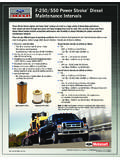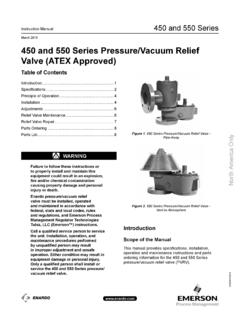Transcription of What do we really know about the number and …
1 What do we really know about the number and distribution of farms and family farms in the world? Background paper for The State of Food and Agriculture 2014 Sarah K. Lowder, Jakob Skoet and Saumya Singh ESA Working Paper No. 14- 02 April 2014 Agricultural Development Economics Division Food and Agriculture Organization of the United Nations Recommended citation Lowder, , Skoet, J. and Singh, S. 2014. What do we really know about the number and distribution of farms and family farms worldwide? Background paper for The State of Food and Agriculture 2014. ESA Working Paper No. 14-02. Rome, FAO. The designations employed and the presentation of material in this information product do not imply the expression of any opinion whatsoever on the part of the Food and Agriculture Organization of the United Nations (FAO) concerning the legal or development status of any country, territory, city or area or of its authorities, or concerning the delimitation of its frontiers or boundaries.
2 The mention of specific companies or products of manufacturers, whether or not these have been patented, does not imply that these have been endorsed or recommended by FAO in preference to others of a similar nature that are not mentioned. The views expressed in this information product are those of the authors and do not necessarily reflect the views or policies of FAO. FAO, 2014 FAO encourages the use, reproduction and dissemination of material in this information product. Except where otherwise indicated, material may be copied, downloaded and printed for private study, research and teaching purposes, or for use in non-commercial products or services, provided that appropriate acknowledgement of FAO as the source and copyright holder is given and that FAO s endorsement of users views, products or services is not implied in any way.
3 All requests for translation and adaptation rights, and for resale and other commercial use rights should be made via or addressed to FAO information products are available on the FAO website ( ) and can be purchased through What do we really know about the number and distribution of farms and family farms worldwide? Background paper for The State of Food and Agriculture 2014 Sarah K. Lowder, Jakob Skoet and Saumya Singh Food and Agriculture Organization of the United Nations, Rome, 2014 ii What do we really know about the number and distribution of farms and family farms worldwide? Background paper for The State of Food and Agriculture 2014 Sarah K. Lowder, Jakob Skoet and Saumya Singh1 Abstract The agricultural economics literature provides various estimates of the number of farms and small farms in the world.
4 This paper is an effort to provide a more complete and up to date as well as carefully documented estimate of the total number of farms in the world, as well as by region and level of income. It uses data from numerous rounds of the World Census of Agriculture, the only dataset available which allows the user to gain a complete picture of the total number of farms globally and at the country level. The paper provides estimates of the number of family farms, the number of farms by size as well as the distibution of farmland by farm size. These estimates find that: there are at least 570 million farms worldwide, of which more than 500 million can be considered family farms. Most of the world s farms are very small, with more than 475 million farms being less than 2 hectares in size.
5 Although the vast majority of the world s farms are smaller than 2 hectares, they operate only a small share of the world s farmland. Farmland distribution would seem quite unequal at the global level, but it is less so in low- and lower-middle-income countries as well as in some regional groups. These estimates have serious limitations and the collection of more up-to-date agricultural census data, including data on farmland distribution is essential to our having a more representative picture of the number of farms, the number of family farms and farm size as well as farmland distribution worldwide. Keywords: family farm; small farm; farm size; smallholders; farmland distribution JEL codes: O13, Q10, Q15, Q24 1 Sarah K.
6 Lowder and Jakob Skoet are with the Agricultural Development Economics Division (ESA) of the Food and Agriculture Organization of the United Nations. Saumya Singh, from Princeton University ,volunteered with ESA during the summer of 2013. For any questions or comments, please contact iii Contents Acknowledgements .. iv 1. Introduction .. 1 2. Limitations of the data and estimates .. 1 3. How many farms are there in the world? .. 3 4. What is family farming? .. 5 5. How prevalent are family farms worldwide? .. 7 6. What do we know about average farm size? .. 9 7. How large are the world s farms? .. 11 8. What can we say about farmland distribution? .. 12 9. Conclusions .. 18 Works 19 Annexes 1 6: Country level data .. 21 iv Acknowledgements This paper was prepared as background research in support of FAO s forthcoming The State of Food and Agriculture 2014.
7 The report will be available at The authors are most grateful for the provision of agricultural census reports by the Statistics Division of FAO. Helpful feedback was received from numerous colleagues. In particular, the authors wish to thank Jairo Castano, Adriana Neciu, Terri Raney, Andr Croppenstedt, Cheng Fang, Michelle Kendrick, George Rapsomanikis, Kostas Stamoulis and Dominique Van Der Mensbrugghe (FAO). Any errors and omissions are those of the authors. ESA Working Paper No. 14-02 1 1. Introduction The agricultural economics literature provides various estimates of the number of farms and small farms in the world. Nagayets (2005) used agricultural census data from FAO to estimate that there are about 525 million farms of all sizes in the world. Other authors use similar data to maintain that there are about 500 million small farms (those with less than 2 hectares) (Hazell, Poulton, Wiggins, & Dorward, 2010) (IFAD, 2011).
8 This paper is an effort to provide a more complete and up to date as well as carefully documented estimate of the total number of farms in the world, as well as by region and level of income. It provides some estimates of the number of family farms, the number of farms by size as well as the distibution of farmland by farm size. These estimates find that there are at least 570 million farms worldwide, of which at least 500 million can be considered family farms. Estimates are made using data from numerous rounds of the World Census of Agriculture (WCA), the only survey program which describes the entire farming sector for countries throughout the world in an internationally comparable manner. The WCA was first conducted in 1930 and FAO has promot ed it since 1950. For the first six rounds (from 1930 to 1980) countries conducted the census in the same year, but for the 1990 census, this constraint was relaxed and countries conducted the census during the period 1987 1993 (FAO, 2005).
9 The 2000 and 2010 rounds span the periods 1996 2005 and 2006 2015, respectively. FAO works closely with many member governments providing guidance on methodology and contents for the agricultural census. Agricultural censuses are typically representative of all farms or farm households in a country; they are conducted by using complete enumeration and/ or sampling methods. FAO recommends the census include a core module on number of holdings and household size and status as well as 12 supplementary themes, which are: agricultural land; irrigation and water management; crops; livestock; agricultural practices; agricultural services; demographic and social characteristics; farm labour; household food security; aquaculture; forestry and management of the holding. Agricultural holdings and agricultural area reported by the census include crop and livestock production only; holdings engaged in forestry or fisheries are only included if they also are engaged in crop and livestock production.
10 That is, when a country chooses to report on units which are purely used for forestry or fisheries, they are described separately and as part of the supplementary theme. 2. Limitations of the data and estimates Problems arise when making international comparisons and global estimates using the agricultural census data, since information is not available for each indicator in every country and all decades. Furthermore, although the WCA provides a large degree of standardization among countries, there is naturally variation among countries in terms of how they define indicators. For this paper we have chosen to combine estimates from numerous census rounds. We use the most recent observation we were able to reasonably locate for each indicator-country combination. This approach is by no means without fault, since, as the available data show us, the farm sector is dynamic and the number of farms in a country changes greatly over time.















